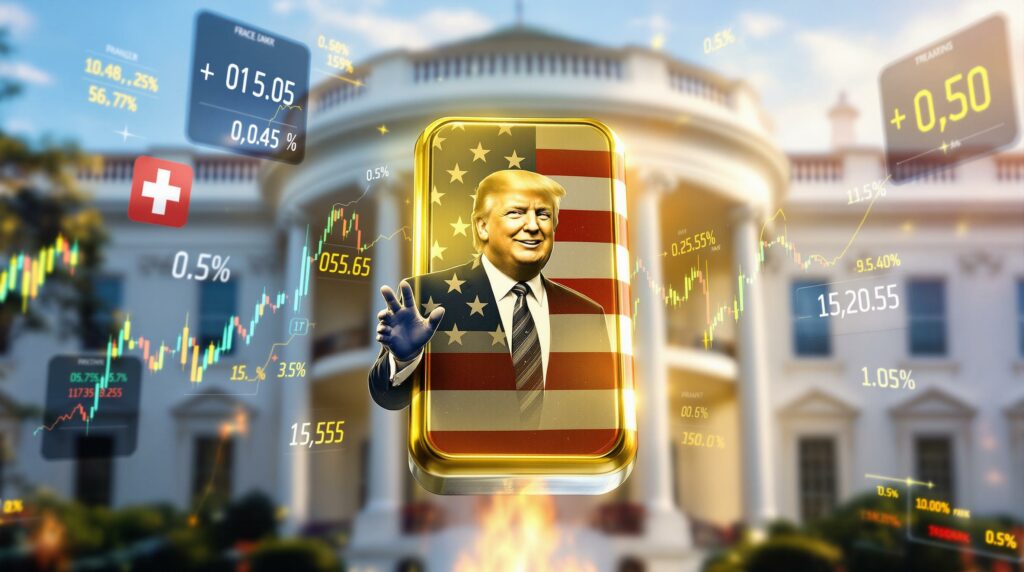Understanding the Gold Tariff Confusion
The global gold market experienced significant disruption recently when US Customs and Border Protection unexpectedly ruled that one-kilogram and 100-ounce gold bars from Switzerland would be subject to a substantial 39% tariff. This ruling sent shockwaves through precious metals markets as it directly contradicted the industry's longstanding understanding that gold bars would remain exempt from President Trump's reciprocal tariff policies.
The announcement created immediate market uncertainty, with traders reporting that gold shipments were "freezing up" as market participants scrambled to assess the potential financial impact of these new duties. One Swiss gold refiner had inquired about tariff applicability to gold bars, triggering the ruling letter that upended market expectations.
"Shipments were freezing up in response to the decision that gold imports would face US duties," traders reported on Friday, highlighting the immediate supply chain disruption caused by the announcement.
The financial impact was equally dramatic. Gold futures on the Comex exchange jumped to record high gold analysis following the tariff news, with New York futures developing a premium exceeding $100 per ounce over the London benchmark – an unusually large spread that signaled serious market dislocation.
This premium reflected growing concerns about physical gold availability in US markets, as Switzerland serves as a major global hub for gold refining and exports. The unexpected tariff created questions about future supply routes and pricing mechanisms that rippled through international gold trading networks.
The Unique Nature of Gold in Global Trade
Unlike industrial metals such as copper, steel, and aluminum – which have previously faced Trump's tariffs – gold occupies a distinctive position in global commerce. It functions simultaneously as a physical commodity and a financial asset/global currency, making trade restrictions particularly problematic for market functioning.
This dual nature places gold in a specialized category that typically receives different treatment in trade policies compared to purely industrial metals. The temporary confusion surrounding its tariff status highlighted the complex intersection between trade policy and financial market infrastructure.
What Was the White House's Response?
In response to the market turbulence, the White House quickly moved to address what it termed "misinformation" about gold tariffs. Administration officials announced plans to issue a clarifying executive order in the "near future" to resolve the confusion.
A White House representative, speaking on condition of anonymity due to the sensitivity of ongoing trade discussions, confirmed the administration's intent to "clarify what an official called misinformation about the tariffing of gold and other specialty products." This acknowledgment suggested recognition at senior levels that the initial ruling had created unintended consequences in precious metals markets.
The clarification aimed primarily to stabilize markets that had been significantly disrupted by the unexpected tariff interpretation. The White House's swift response indicated an understanding of gold's unique position in global financial infrastructure and the potential ripple effects that tariff uncertainty could create beyond just physical metal trading.
Special Status Recognition
The administration's response appeared to recognize gold's special classification within global trade. Unlike consumer goods or industrial commodities, gold serves multiple economic functions – from industrial component to investment vehicle to central bank reserve asset. This multifaceted role necessitates careful consideration when applying broad trade policies.
The promised executive order would likely address not only gold specifically but also "other specialty products" – suggesting a more nuanced approach to certain categories of imports that function differently within global commerce and financial systems.
Why Is Gold Treated Differently Than Other Metals?
Gold's exceptional status among metals stems from its dual nature as both a physical commodity and a financial asset. While industrial metals like copper, steel, and aluminum primarily serve manufacturing purposes, gold functions as a globally recognized store of value and alternative currency.
This unique role means that disruptions to gold's physical movement across borders can have outsized impacts on financial markets compared to other metals. As Bloomberg analysis noted, "Gold has a unique role as a financial asset and global currency, making it different than copper, steel and aluminum — other metals that have been hit by Trump's tariffs."
Financial Market Implications
The potential tariff would have had "sweeping implications for bullion around the world, and could have disrupted the functioning of the US futures contract," according to market analysis. This highlights how gold's special status creates interconnections between physical supply chains and sophisticated financial instruments.
Gold futures contracts rely on efficient cross-border movement of physical bullion for proper settlement. Any significant barrier to this movement – such as a 39% tariff – could potentially compromise the integrity of these financial markets by creating delivery complications or pricing distortions.
Central Bank Considerations
Gold also serves as a strategic reserve asset for central banks worldwide, including the Federal Reserve. This monetary role further distinguishes it from industrial metals and creates additional policy considerations when contemplating trade restrictions.
Recognizing this distinction appears to have been a factor in the White House's quick move to address the tariff confusion. Maintaining efficient functioning of gold markets serves broader financial stability goals beyond simple trade policy objectives.
How Did Markets React to the Tariff News?
Initial Market Response
The gold market's reaction to the tariff announcement was swift and dramatic. Gold futures prices on the Comex exchange surged to record highs as traders priced in the potential supply disruption and higher costs. The immediate concern centered on how Swiss gold – from one of the world's premier refining hubs – would continue flowing to American markets.
The price premium between New York futures and London spot prices expanded to more than $100 per ounce – an extremely unusual divergence that highlighted serious market stress. This pricing anomaly reflected fears about physical delivery capabilities for US futures contracts if Swiss gold imports faced significant barriers.
Physical gold shipments began "freezing up" according to trader reports, as market participants hesitated to initiate new transfers that might suddenly become subject to substantial duties. This temporary paralysis in the supply chain demonstrated how quickly uncertainty can affect market functioning.
Post-Clarification Adjustment
Following the White House announcement about the upcoming executive order, markets began to stabilize. According to Reuters reports, "Spot gold and futures prices on New York's Comex fell after the White House statement," indicating relief that the administration recognized the need for policy clarification.
This price correction reflected growing confidence that gold's special status would ultimately be preserved in trade policy. However, market participants remained watchful for the official executive order details, maintaining a cautious approach until formal clarification was published.
The episode demonstrated gold's heightened sensitivity to policy shifts compared to many other commodities, with even temporary uncertainty capable of triggering significant price volatility and trading pattern disruptions.
What Are the Broader Implications of the Gold Tariff Issue?
The gold tariff confusion raised several important questions about international trade relationships, market functioning, and policy implementation that extend beyond this specific incident.
International Trade Dynamics
The initial ruling would have significantly affected major gold exporters, particularly Switzerland, which serves as a global hub for gold refining and trading. The 39% tariff specifically targeting Swiss goods would have dramatically altered established trade flows and potentially shifted refining activities to other jurisdictions.
This situation highlighted how targeted trade policies can have unintended consequences for specialized markets with complex international supply chains. Gold's movement across borders involves numerous intermediaries and sophisticated logistics networks that can be disrupted by sudden policy shifts.
Futures Market Infrastructure
Perhaps most significantly, the episode demonstrated the close connection between physical commodity movement and financial market functioning. As the Bloomberg report noted, the tariff "could have disrupted the functioning of the US futures contract" – potentially affecting not just gold traders but broader financial markets where gold futures serve important hedging and price discovery functions.
Market Insight: Gold futures contracts require reliable physical delivery mechanisms to maintain pricing integrity. Any significant barrier to physical delivery can create settlement problems and undermine market confidence.
The potential disruption to established delivery mechanisms raised questions about how other financial commodities might be affected by future trade policy decisions. Market participants will likely scrutinize future tariff announcements more carefully for similar unintended consequences.
Investment Strategy Implications
For gold investors, the episode serves as a reminder that policy risk extends beyond monetary and fiscal decisions to include trade policy. Portfolio managers may need to consider geographic diversification of physical gold holdings and examine alternative investment vehicles that might be less affected by potential future trade restrictions.
Institutional investors in particular will likely conduct deeper due diligence on the potential trade policy exposure of various precious metals investment options, potentially favoring structures with built-in flexibility to adapt to changing regulatory environments.
How Do Gold Tariffs Fit Into Current Trade Policy?
The gold tariff confusion emerged directly from President Trump's broader "reciprocal tariffs" policy, which aims to impose equivalent trade barriers on countries that maintain barriers against US exports. Within this framework, Switzerland was specifically targeted with a 39% tariff on its goods.
This approach represented a significant shift from traditional trade policy approaches, creating new uncertainty about which products might face restrictions. The gold situation demonstrated how broad policy initiatives can create unexpected complications when applied to specialized markets with unique characteristics.
Policy Clarification Needs
The episode highlighted the importance of clear guidance when implementing complex trade policies. The initial ruling letter from US Customs and Border Protection created immediate market disruption precisely because it contradicted industry understanding about gold's exemption status.
This miscommunication suggests potential process improvements in how trade policies are developed, communicated, and implemented – particularly for products that serve multiple economic functions like gold. Greater advance consultation with affected industries might help identify potential complications before policies are announced.
Financial Market Considerations
The swift White House response indicates recognition that trade policy must balance multiple objectives, including maintaining financial market stability. The promised executive order clarification demonstrated how administration officials weighed competing priorities when unexpected consequences emerged.
This balancing act between trade policy goals and market functioning considerations will likely remain an ongoing challenge as reciprocal tariff policies continue to evolve. Future trade actions may incorporate more explicit carve-outs or special provisions for financial commodities to avoid similar confusion.
FAQ: Gold Tariffs and Market Impact
What specific gold products were initially ruled subject to tariffs?
The US Customs and Border Protection ruling specifically addressed one-kilogram and 100-ounce gold bars from Switzerland. These standardized formats are commonly used in professional trading and investment, making them particularly important for market functioning. The ruling came in response to an inquiry from a Swiss gold refiner seeking clarification on tariff applicability.
How did gold prices respond to the tariff news cycle?
Gold futures prices on the Comex exchange initially surged to record highs following the tariff announcement, with New York futures developing a premium exceeding $100 per ounce over the London benchmark – an unusually large spread. After the White House announced plans for a clarifying executive order, both spot gold and futures prices on the Comex declined as market concerns eased.
Why would gold tariffs potentially disrupt US futures contracts?
US gold futures contracts rely on efficient physical delivery mechanisms to maintain proper functioning. Contract holders have the right to take delivery of physical gold upon expiration, which requires reliable import channels from major refining centers like Switzerland. A significant tariff would disrupt this delivery process by:
- Adding substantial costs to physical settlement
- Potentially reducing available supply for delivery
- Creating pricing distortions between physical and paper markets
- Complicating warehouse logistics and transportation
These disruptions could undermine confidence in the futures market and potentially lead to market liquidity problems.
What is the significance of Switzerland in global gold markets?
Switzerland occupies a central position in global gold supply chains for several reasons:
- Refining capacity: Swiss refineries process approximately 70% of the world's gold annually
- Quality standards: Swiss hallmarks are globally recognized and trusted
- Financial infrastructure: The country's banking system specializes in precious metals trading
- Geographic position: Central location between mining regions and consumption markets
- Technical expertise: Long history of metallurgical knowledge and precision
This concentrated role makes Swiss gold particularly important for international market functioning, especially for standardized investment products like the bars affected by the tariff ruling.
How might gold investors protect themselves from similar policy uncertainties?
Prudent strategies for managing trade policy risk in gold investments include:
- Diversifying physical storage locations across multiple jurisdictions
- Utilizing multiple investment vehicles (ETFs, mining stocks, futures, physical)
- Maintaining relationships with multiple dealers to ensure supply options
- Staying informed about developing trade policies affecting precious metals
- Considering sovereign risk factors when selecting storage jurisdictions
- Examining insurance coverage for policy-related disruptions
- Maintaining some allocation to domestic gold sources less affected by import restrictions
Key Takeaways About Gold Tariff Policy
Unique Asset Recognition
The White House's quick move to address gold tariff misinformation demonstrates recognition of gold's special status in global financial markets. Unlike purely industrial commodities, gold's dual role as physical asset and financial instrument creates unique policy considerations that appear to have motivated the administration's clarification efforts.
This recognition may set precedent for how other financially-significant commodities are treated in future trade actions. The episode highlights the complex interconnections between physical commodity markets and financial systems that policymakers must navigate.
Policy Clarification Process
The administration's decision to address market confusion through an executive order suggests a pragmatic approach to resolving unintended consequences of broad trade policies. This mechanism allows for relatively quick adjustments when market reactions reveal potential problems with initial policy interpretations.
The process demonstrates how trade policy implementation involves ongoing refinement rather than one-time pronouncements. Market participants should anticipate similar clarifications and adjustments as reciprocal tariff policies continue to evolve across different product categories.
Market Sensitivity
The episode clearly demonstrated gold markets' extreme sensitivity to potential trade barriers. Even before formal implementation, the mere prospect of tariffs created significant price volatility, trading pattern disruptions, and physical supply chain hesitation.
This sensitivity stems from gold's special characteristics:
- Global trading across multiple jurisdictions
- Physical delivery requirements for financial contracts
- Narrow refining and assaying requirements
- High-value density making transportation costs normally minimal
- Standardized specifications requiring specific supply sources
Continued Vigilance Needed
While the White House clarification provided immediate market relief, participants should monitor the final executive order language for complete clarity. The devil often lies in the details of trade policy implementation, with specific definitions and exemption language determining actual market impact.
The situation remains fluid until formal documentation is published, making continued attention to policy developments essential for anyone involved in gold trading, investment, or industrial usage. The episode serves as a reminder that even well-established markets can face sudden disruption from unexpected policy shifts.
Furthermore, investors should stay informed about the gold price forecast and understand the relationship between gold stock market guide to navigate these uncertain times. Many investors turn to gold as an inflation hedge during periods of market turbulence, while others seek to understand the factors behind the recent historic surge explanation in gold prices.
Searching for Early Notification on ASX Gold Discoveries?
Discover significant gold investment opportunities before the market with Discovery Alert's proprietary Discovery IQ model, which instantly identifies high-potential ASX announcements and delivers real-time alerts on major mineral discoveries. Explore why historic discoveries can generate substantial returns by visiting Discovery Alert's dedicated discoveries page and position yourself ahead of the market.




